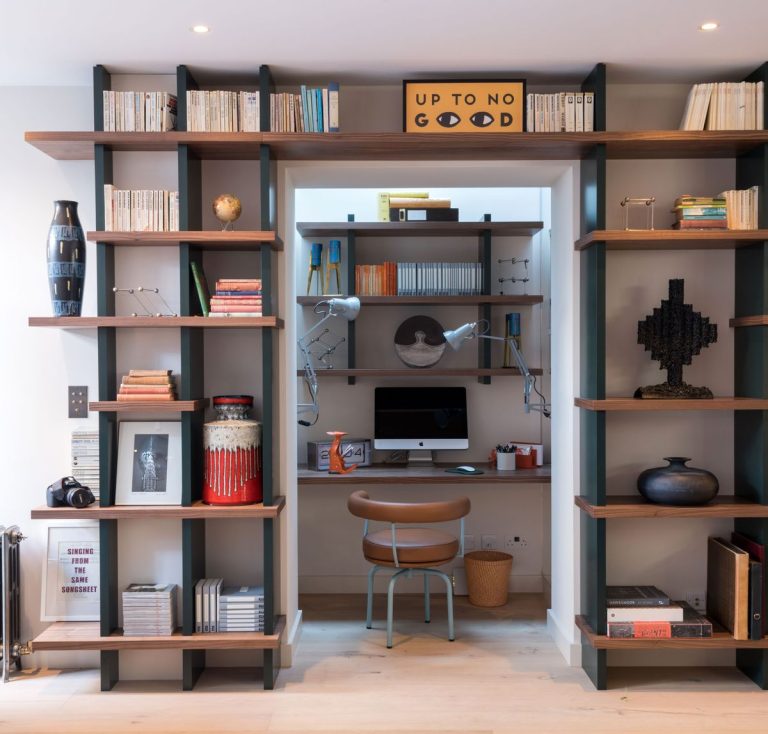Living room home office ideas don't have to be cramped or chaotic – with a little thought, you can harmonize these two very different spaces, meaning your living room can be a functional space for your 9-5 work, but also one that feels peaceful and relaxing.
“With more people now working remotely than ever before, it's becoming common to have a home office in your living room,” explains interior designer Megan Molten. But what are the alternative solutions to having extra space for working from home?
“It's important to take the time to organize and incorporate pieces that complement your living space while keeping your desk clutter-free,” says Megan. “Bring in a console or storage baskets to give you more space to store your things. Your small home office in your living room should be an extension of your design aesthetic; it doesn't need to be an eyesore.”
To create a dedicated area for your home office in your living room, we spoke to interior designers to get their best tips. Here's what they had to say…
10 Best Ideas for a Dual-Purpose Home Office in Your Living Room
1. Organize your space
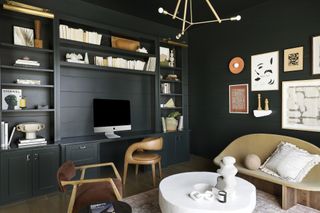
(Image courtesy of Matti Gresham. Design: Urbanology)
If you're wondering how to work effectively from home, Charleston-based interior designer Megan Molten suggests creating a dedicated space for everything.
“Organization is about making the most of your space and creating functional zones that blend seamlessly with the style of your home,” says Megan. “Keep desk accessories to a minimum to avoid it looking cluttered. We suggest placing frames and candles on a small round tray. Make sure you choose finishes and accessories that complement your living space.”
Megan suggests maximizing drawer and cabinet space, making sure to retain style elements that reflect the design of your home. She says, “Incorporating linen boxes, woven baskets and consoles will provide additional storage while blending into the space. Again, keeping your desk organized is key.”
2. Make your desk a hidden gem
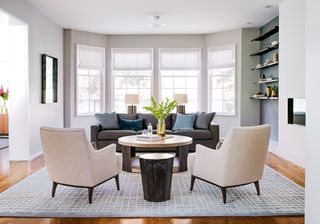
(Image courtesy of Niche Interiors)
At first glance, you wouldn't realize that this living room also houses a dedicated home office.
But this clever design by Jennifer Jones of Niche Interiors features a console desk behind the sofa with an ottoman tucked underneath — which Jones says is one of two design approaches her team uses to incorporate workspaces into living rooms.
“A good starting idea is to have a console table behind the couch that can double as a desk,” Jones says. “Often with an ottoman underneath so you can pull out your laptop for short periods of time. For a more serious, permanent work environment, it's best to divide the space into zones and place a large desk to one side of the room, ideally near a window.”
But when designing a multi-purpose space, Jones stresses that it's always best to consider how a piece of furniture will look from different angles, “especially if it's going to feel like it's floating in the room,” she says.
3. Adequate storage space is key
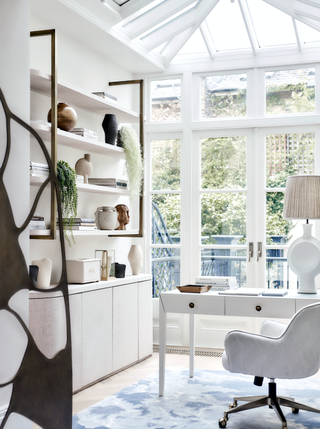
(Image courtesy of Gunter & Co)
With a living room home office, it's important to make sure your work-from-home equipment doesn't encroach on your relaxation space — after all, you don't want to be thinking about work at 5pm.
“This means you can tuck your laptop or work phone away when you're done,” explains Eileen Gunter of Gunter & Co. Interiors. “If it's out of sight, it's likely to be forgotten.”
“We work with highly skilled carpenters who create incredibly practical, yet beautiful, storage ideas to suit your style and the way you organise your life,” she adds. “Successful storage always requires plenty of advance planning – think about how you want to use the space, what you want to hide and what you want to proudly display.”
Eileen's top tip? “Personally, I like to create docking drawers for each family member so they can charge their laptops, iPads and phones overnight.”
4. Create clear divisions
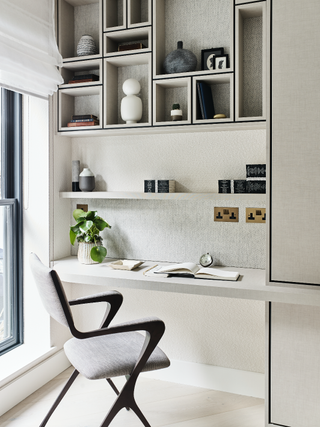
(Image courtesy of Gunter & Co)
If your home office is part of an open-plan space, try to create a clear division between work and living areas.
“Having a clear separation between the two helps you to compartmentalize mentally,” says Eileen. “For example, this Chelsea townhouse uses Tom Faulkner's stunning Papillion Screen to nicely separate the living area from the home office while still maintaining a sense of flow. An added benefit of the screen is that it's easy to move, making it easy to switch up the layout as needed.”
Folding screens and room dividers have been making a bit of a comeback recently, especially during the pandemic as people have been forced to blend working from home with their nine-to-five jobs.
5. Focus on biophilic design
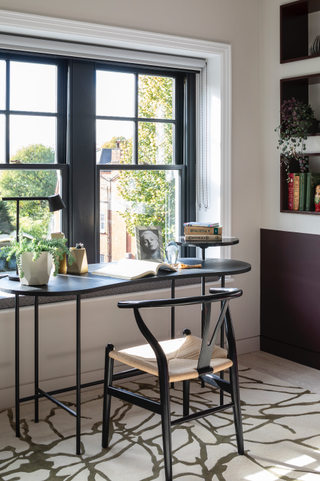
(Image courtesy of Gunter & Co)
Biophilic design is a huge trend in interior design – and we totally support it.
“We all have an innate desire to connect with nature, which has a positive impact on our mental and physical wellbeing,” explains Eileen. “In recent years, there has been a surge in interest in biophilic design, which seeks to bring elements of the natural world into the home.”
This can include everything from incorporating exterior views to incorporating natural materials in finishes.
“One of the easiest ways to incorporate biophilic design into your home office is to make sure it has a great view, ideally with lots of greenery,” says Eileen. “If your home's layout doesn't allow for this, the next best thing is to incorporate larger houseplants into your floor plan and place smaller potted plants on desktops, windowsills or shelves. Other ways to bring a touch of the natural world into your home office include painting it in neutral colours, hanging nature-inspired artwork and thinking about how to maximise natural light.”
6. Make use of nooks and crannies
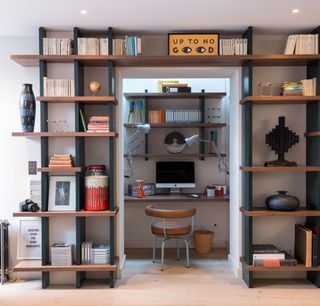
(Image courtesy of Mark O'Flaherty)
As you can see from this design, an awkward space, a boxy recess, or a perfectly imperfect and unused corner provides the perfect space for a home office in your living room.
“Nooks and alcoves are great locations for a home office because they're set back from the main living space,” says Katie Glaister, founder of K&H Design and architect of the project. “In the client's basement living area, we were delighted to find a space beneath a side path that leads to the garden where we could create a home office.”
“Light from above and mirrored sides of the alcove make the space feel larger,” she adds. “Design custom shelving to create zones in your home office and add extra storage space.”
7. Soundproof your space if possible
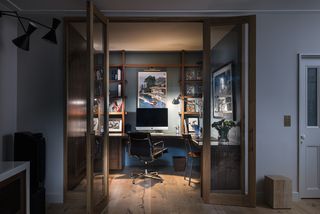
(Image courtesy of Paul Raeside)
Both offices and living spaces can be noisy places, especially if you're working in a small living room while others are relaxing in the living area. The key?
“To ensure function rooms work harmoniously together, make sure your home office isn't located near the TV or lounging area,” says Katie Glaister.
“Insert glass or Critol doors for soundproofing and to increase privacy in your home office while still maintaining a connection to your living room.”
8. Use color to divide your space
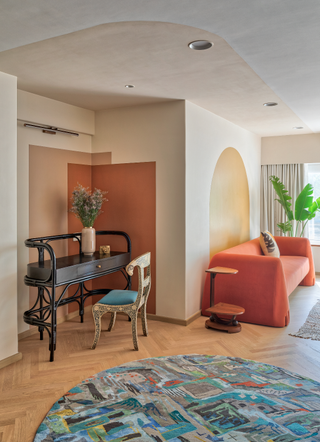
(Image courtesy of Noorin Kapoor)
Love color? Injecting bright, beautiful hues into your space can liven up any room, as shown in our colorful living room ideas. Interior designer Noorein Kapoor recommends incorporating pops of color in your living room to intentionally separate work and living areas.
“Working from home comes with inevitable distractions,” says Nourin. “With Netflix and the kitchen within a few feet of each other, it's easy for your work to be impacted. Positioning your desk facing a wall or window (not the TV) and organizing your space can help combat attention-stealing household items.”
“You could even designate an empty corner as your new living room office,” suggests Noorein. “The best setup for a living room office requires a balance of shared spaces blending into one another while still maintaining their individual functions.”
solution?
“To create a work area in the living room, we divided the space with panels of color, in this case a desert color palette. Also, in this case, there were natural gaps in the living room that helped create dividers and separate areas.”
9. Have a clear path
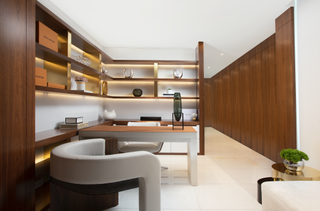
(Image courtesy of Alexia Fodere)
Another way to truly separate your living room from your home office is to have a clear path to your telecommuting space.
“It's really important to have a clear path through the room,” says interior designer Ariana Castro of Britt Charette, “and make sure to incorporate furniture that blends with what's already in your living room. And keep it clutter-free and free of clutter.”
10. Use multi-functional furniture
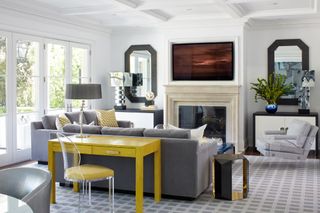
(Image courtesy of Ann Hepfer)
Multifunctional furniture is a must for any living room, especially if you are planning to turn this room into a dual space.
So, look for furniture that can be multifunctional: think an ottoman to store all your papers, a coffee table with drawers, and a console table where you can place a desk.
Sara Malek Barney of BANDD/DESIGN agrees: “If you're incorporating a home office space into your living room, you should consider using multifunctional furniture,” she says.
“If you have a console behind your couch, just pull out a chair, add a few accessories, and you're ready to tackle your inbox. You can also use a built-in or small niche to set up a workspace. Add a comfortable chair and some organizational items to complete the look.”
“For this project, we took a sofa table and adapted it in a different way, creating one of our custom Ahadachou Yellow desks,” says interior designer Ann Hepfer. “It's a unique way to create a workspace at home when you don't have the space for an office at home. All you need is a lamp and a desk chair to accessorize the console table, making styling simple and easy.”
But remember: “Try to stick to décor that fits with your current design — keep everything harmonious, organized, and streamlined,” adds Barney.
Where should you place your home office in your living room?
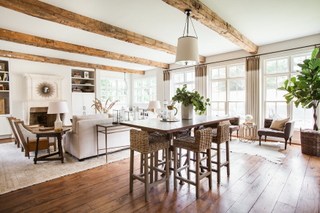
(Image courtesy of Julie Soefer)
Poor lighting can lead to fatigue, headaches, and eye strain, especially if you're working at a computer for eight hours. “Always consider natural light,” says Houston-based interior designer Marie Flanigan. “Natural light can help keep morale high, especially if you're working alone at home.”
For best results, position your work-from-home space near a window, near an overhead light, or with a lamp propped up on a table, but don't forget the cardinal rule when turning your living room into a home office: Put away everything you need for work at the end of the day.
“It's important to have time to unwind in your living room at the end of the day,” Marie says. “Plus, if you have an open floor plan, a breakfast table is a great place to unwind. Since your breakfast area is likely used every day, you'll want to clear your work items away at the end of the day.”

